by Editor | Nov 29, 2010 | Luxury Travel
Article and photos by Elena del Valle
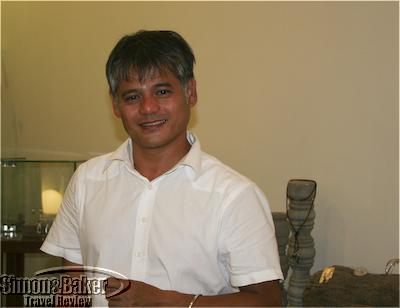
Cambodian silversmith Ly Pisith in his shop
As I sat across from him early one evening in the boutique I noticed his calm demeanor in between the constant interruptions of customers. I sensed kindness, a certain sadness and a quiet strength. Beyond that it was impossible to guess what the welcoming and handsome man was thinking. We spoke easily, switching between languages and topics as the ebb and flow of customers allowed.
At first I didn’t know what stirred disquiet within me. The store was a labor of love filed with distinctive locally inspired pieces on display. Every one of them was a part of a story, his story, I discovered later as we spoke.
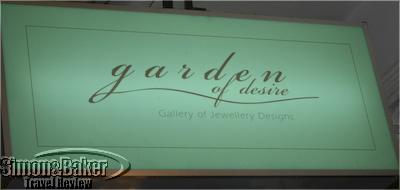
His shop is located in the heart of Siem Reap, Cambodia
Ly Pisith lived a harrowing childhood in Cambodia. After escaping the Khmer Rouge, the despotic regime that killed everyone in his family and forcibly recruited him, he grew up on the streets of the capital city. From the urban center of the country he walked miles upon miles to the border with Thailand where he was taken to a French Red Cross camp.
From there things improved. Eventually he moved to France where he attended school. He studied at the Institut Universitaire de Technologie in Bordeaux and took courses in graphic art and decoration at the Beaux Art de Paris. In time he became successful designing eye wear at Alain Mikkli and Stark, he told me softly in French. But the ghosts of his past haunted him, driving him to return to the land where he lost everything and suffered so profoundly in search of peace and a respite. He believes the path to what he seeks is in Siem Reap, Cambodia confronting the past that is no longer.
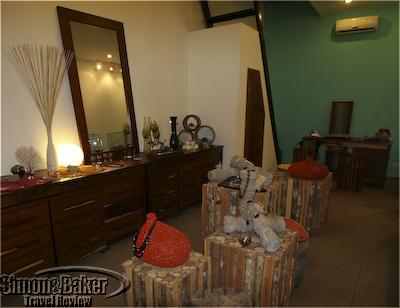
The Garden of Desire displays were locally inspired and made with local artifacts
“I have always a passion in jewelery design. I started young but the designs were for myself and close friends only. It was only two years back when I decided to pursue jewelery design, open up a gallery and made a new career move,” he said.
In 2008, he opened Garden of Desire, a silver jewelry boutique in the heart of Siem Reap near the central market. In the well lit shop decorated with local materials including wood and art based on the designs of the nearby world famous Angkor Temples he sells art as jewelry in contemporary designs. An executive at my hotel recommended the shop after explaining that it was the only jeweler in town he trusted to be reputable due to the many fake precious stones being sold as the real thing even in high end stores. Almost everyone I asked echoed those sentiments. When I asked the shop owner about the situation he agreed it was a widespread problem and the reason he only worked with semi-precious stones.
His designs are wearable art with elements of storytelling; made to be comfortable to wear and stylish. His art is “about encasements of personal stories and reflections.” Cages are a repetitive feature in his work, he explained, because so much of his life is associated with being constrained in some way. Even at the Red Cross camp where he found help he was imprisoned since he was not allowed to leave.
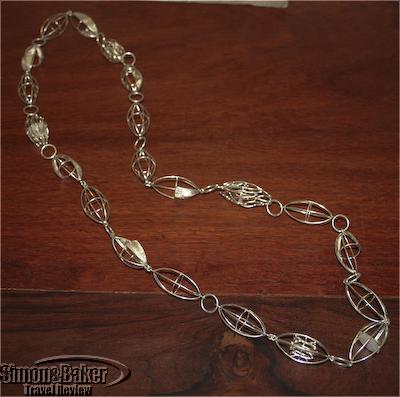
An intricate silver necklace, one of the Caged designs
“The jewelry doesn’t have to be nice. It’s about their personality. They find the right something that tells you something perfectly takes over you. It really has to be something that brings out you. This is my conception of jewelry; and jewelry has a feel, a look,” he said, explaining that it is not necessary for jewelry to make the wearer feel good or nice; he seeks to provide items his customer identify with immediately.
He went on to say that jewelry can express feelings of pain, anguish, and the anxiety of feeling boxed in; his customers browse through the store and find the item they identify with right away. He shares his feelings and his experiences in his jewelry and his customers find the ones that resonate with them.
A couple purchased a ring while I was at the store. They walked around and waited two hours while it was sized rather than give up on the purchase. He sees that desire and that determination often among his customers, he told me when I asked how customers respond to his jewelry.
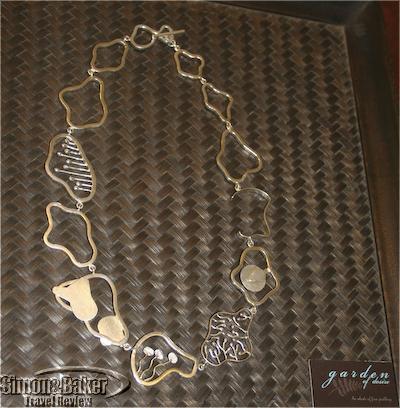
Sculpture as jewelry
“I am always most willing to explain my works to my customers who are keen in my creations. After hearing about the ideas behind their purchase, they are often surprised and value the pieces even more. But my creations can be appreciated on different levels; from the designs to forms,” said the Cambodian artist who was partly self taught in France.
“I am always curious about working with new materials and often I learned from books and through experimentation. I also work with Cambodian artisans. It is a two way learning journey for us. We come up with our own methods,” he said when asked how he learned his trade.

Intricate and thought provoking designs
Some of his series include Weather, about the environment including clouds, rain, organisms and the ozone; Cage which consists of two necklaces. The first speaks of humans trying to control or take over nature. The second necklace illustrates nature overpowering humans and resisting interventions. Series 1 Can You Hear Me? is an abstract image of a land mine victim. Series 2 Can You Hear Me? is also an abstract portrait of a land mine victim. Here the inner voice is expressed through the facial expression, a silent scream.
“Upon seeing the victims and knowing their personal stories, I was intrigued to create a piece of jewelry. This piece shows the figure of the victim. Standing on only one good leg and hand reaching out,” he said.
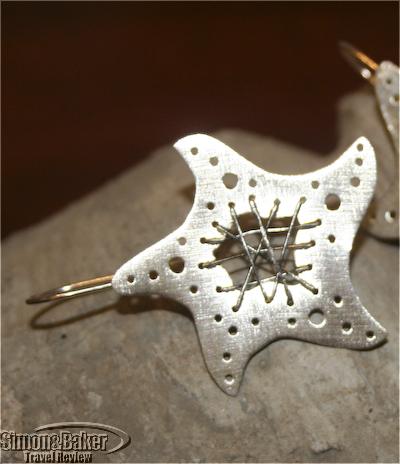
Out of the ordinary star earrings
“Having lived in France for most of my life and traveling around the globe, Cambodia and especially Siem Reap is still close to my heart. I was born in Phnom Penh and travel(ed) to France after the war. Siem Reap is such a charming place with the temples where I can seek peace. I lead a simple yet meaningful life creating my works. I do miss a little the city buzz from time to time where you have everything,” Ly said, explaining that in the future he plans to continue experimenting with new materials beyond silver. Garden of Desire, The Passage-Old Market Area, Siem Reap, Kingdom of Cambodia, +855 12 319116, www.gardenofdesire.wordpress.com, gardenofdesire@ymail.com
by Editor | Nov 22, 2010 | Books
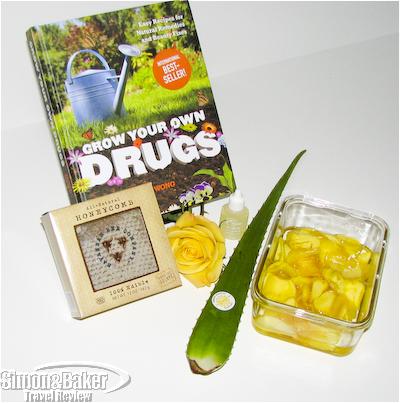
Ingredients for chapped lips balm recipe
Herbal enthusiasts wishing to find home remedies for simple maladies have a new resource, Grow Your Drugs: Easy Recipes for Natural Remedies and Beauty Fixes (Reader’s Digest, $19.95) by James Wong, host of a BBC series by the same name. There are 60 recipes for natural teas, creams, lotions, balms, gargles and cough syrups in the 224-page hardcover book with 150 color photos published earlier this year.
Many of the recipes are accompanied by color photos and step-by-step instructions. The book is divided into: Introduction, Getting Started, Remedies, Top 100 Medicinal Plants, Resources, Index and Acknowledgements. Wong provides recipes to deal with skin ailments including Athlete’s foot, eczema, insect bites and stings, acne, sunburn, age spots, fungal conditions, burn scars, poor foot circulation and chapped hands; digestive issues like bad breath, heartburn and indigestion, irritable bowel syndrome, constipation, flatulence, and diarrhea; children’s needs such as vitamin booster, head lice, ear wax build-up, and colic; Aches and Pains: Water retention, varicose veins, aching muscles, arthritis; and women’s problems like hot flashes, night sweats, morning and travel sickness, PMS, and cystitis.
He also offers suggestions for colds and flu, coughs and sore throats, cholesterol reduction, hangover, cold sores, immune system booster, mouth ulcers, restorative, memory enhancer, insomnia, migraine prevention, anxiety, hair strengthener, body scrub, bath and massage oil, deodorant, face mask, hand care, exfoliator, face toner and hair rinse, tired or red eyes, glycerin soap, plaque remover and gum soother, and chapped lips.
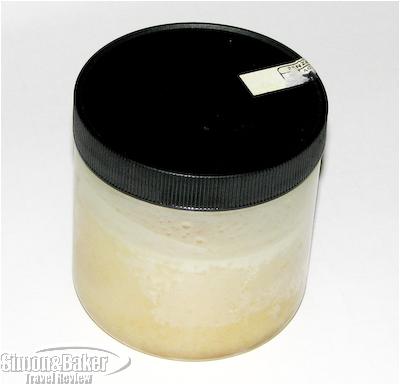
We placed the lip balm in a glass jar with a wide neck and kept it refrigerated
We tried the chapped lips recipe which required organic and fragrant rose petals, vitamin E oil, bees wax, honey, cheesecloth and aloe vera gel (optional). The biggest challenge was obtaining organic fragrant rose petals in our area. We located organic roses at the local branch of a national health food chain although the fragrance was rather muted. We couldn’t find bees wax so we substituted honeycomb for the bees wax. The resulting balm solidified in the refrigerator although it seemed too soft to carry around.
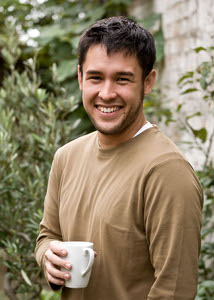
Author James Wong
James Wong, who grew up in Malaysia and Singapore, trained at the Royal Botanical Gardens, Kew and received an MSc in Ethnobotany from the University of Kent graduating with distinction. His research has taken him to highland Ecuador, as well as to China and Java. The University of Kent lecturer, an enthusiast about the utilitarian value of plants, co-designed and built two medal-winning gardens (in 2004 as the youngest medal winner and again in 2008).
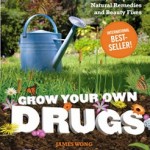
Click here to buy Grow Your Own Drugs
by Editor | Nov 15, 2010 | New Articles, Restaurants
Article and photos by Elena del Valle
On a recent visit to Siem Reap, Cambodia I had the pleasure of dining at Meric, the gourmet restaurant of my stylish and centrally located hotel. Named after the highly sought-after Cambodian pepper grown in the Kampot region Meric served a seasonally-inspired Khmer menu using the produce of local farmers. Established in 2005, the 217 square meter restaurant was in the capable hands of American Chef Bryan Gardner, who had just become executive chef, and Restaurant Manager Sokthea Mao. They and their enthusiastic team of 18 produced some memorable meals.
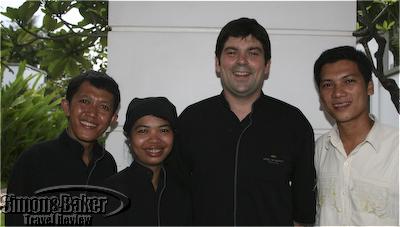
Chef Bryan Gardner and his staff
Chef Gardner grew up in Eastport, Maine known for its seafood. After attending the University of Southern Maine, he pursued a Culinary Arts degree at the New England Culinary Institute in Vermont. In 2005, he went to the Martini House in Saint Helena, Napa Valley before working with Joseph Humphrey, chef at the Meadowood Resort (a Relais and Chateaux property). He later worked under Japanese Chef Hiro Sone at Terra, where he observed the fusion of Asian and Western cuisines. In 2007, his passion for Asian cooking drew him to South East Asia where he fell in love with Cambodia. In July 2010, after working for two years at Hotel de la Paix as sous chef he became executive chef of the hotel’s restaurant. One of his goals is to raise the profile of Khmer cuisine within Asian and international circles alongside a la carte dishes with French, American and Asian influences.
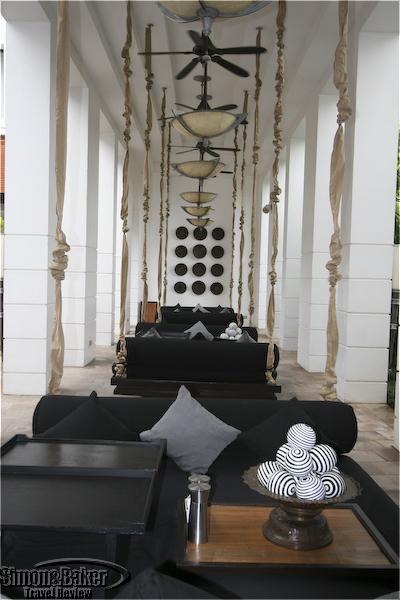
Outside swing seating facing the courtyard
I particularly liked the restaurant’s dining swings set along a tranquil internal courtyard with a water feature. This was my favorite area of the hotel. The restaurant, said to have one of the largest collections of international wines in Siem Reap, could accommodate up to 108 guests, 64 indoors and 44 outdoors. I liked the outdoors best, especially at a table with a view of the courtyard.
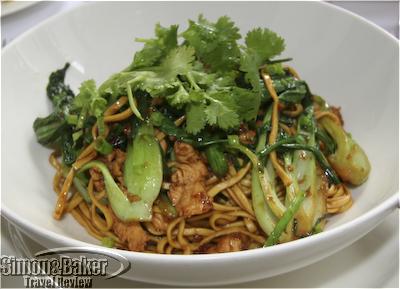
A Cambodian breakfast dish with fresh herbs and vegetables
Although the menu changed daily depending on the produce available from the local farmers and growers, while I was at the Hotel de la Paix where the restaurant is housed, I sampled the seven-course Khmer Tasting Menu. It was outstanding and, at $31 per person, an excellent value for money.
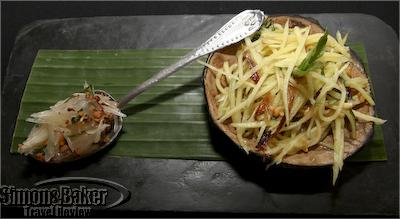
One of the courses from the Meric Khmer Tasting Menu
Twice I had the tasting menu. The first time on a Monday I had Pomelo Salad with Prawn served at the same time as Chicken and Banana Bud Salad. Next there was Grilled Beef with Cucumber and Prahok Sauce served with Khmer organic white rice next to Pork Rib Sour Soup “Jungle Style.” Next there was Stir Fried Frog with Fresh Ginger served at the same time as Cat Fish and Green Curry. The final dish was a small tray of Assorted Khmer Sweets for each of us.

Dishes were served in pairs for contrast
On Wednesday, I had Pomelo Salad with Crispy Pork Fritter served at the same time as Green Mango Salad with Dried Snake (both favorites). Then there was Grilled Prahok with Khmer Crudites served with Khmer organic white rice at the same time as Prawn with Water Lily Sour Soup. The final savory courses served at the same time were Stir Fried Frog with Ginger (had a definite bite) and Beef Shank Curry with Morning Glory (a favorite). For dessert there were assorted Khmer Sweets. Of the two tasting menus the first was my favorite although both were outstanding and worth a detour.

Dessert was a stylized interpretation of Khmer classics
Congratulations to the team at the Meric restaurant for its noteworthy gourmet dining. Visit the Simon & Baker Travel Review for additional information about Siem Reap and the Hotel de la Paix.
by Editor | Nov 8, 2010 | Accomodations, New Articles, Spas
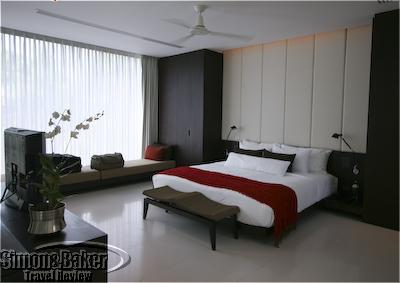
The bedroom in a three level suite at the Residences at Twinpalms Phuket
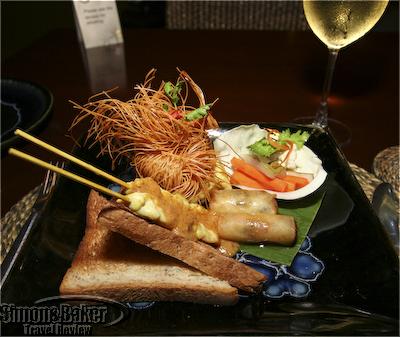
A tasty and attractive appetizer
When one of our team members was in Phuket, Thailand recently she spent time at Twinpalms Phuket, a luxury adults oriented hotel on the west side of the popular island. She liked the ultra private and luxurious accommodations in the Residences building including a three level suite with a rooftop pool and a shared concierge.
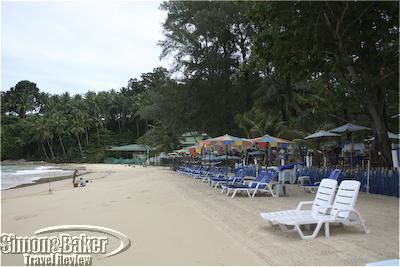
The beach
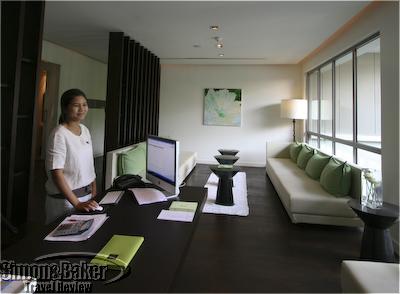
Palm Spa at Twinpalms Phuket
Thinking of traveling to Phuket or just curious? Visit the Thailand page of Simon & Baker Travel Review to read a dedicated property profile about Twinpalms Phuket and Palm Spa, the property’s in house spa.
by Editor | Nov 1, 2010 | Restaurants and Food
Article and photos by Elena del Valle
On a recent trip to Phuket, Thailand I dined at The Boathouse, a well known beach side restaurant on the southwestern coast of the island. I sampled the restaurant’s two tasting menus, French and Thai, with wine pairings. Several days later I followed up the success of the meal with a 90-minute cooking class and lunch.
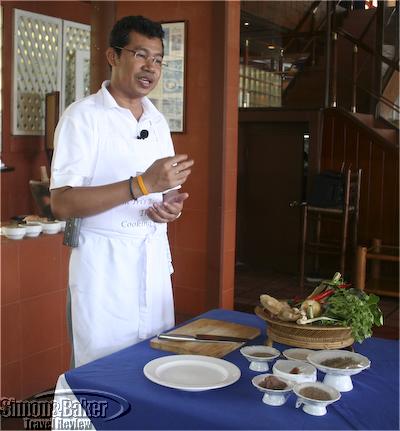
Chef Punchun discusses ingredients
The following Saturday morning I returned to learn about Thai cuisine first hand from Tummanoon Punchun, the restaurant’s executive chef at the time. Since then the chef relocated to Chiang Mai in northern Thailand and Jean-Noël Lumineau, a French chef living in Phuket, took over The Boathouse kitchen. Khun Rattana Pholtaisong, the sous-chef who started working at the Boathouse in 1990 and assisted Chef Punchun during his tenure, has taken over the weekend Thai cooking classes.
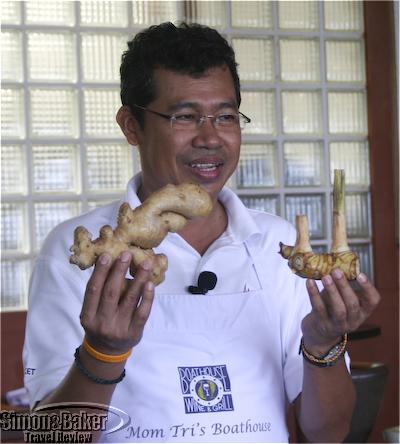
Each ingredient was discussed in detail
For more than a decade, Chef Punchun shared his passion for Thai food and cooking with food enthusiasts during weekend Thai cooking classes in English (the chef had a thick Thai accent and spoke quickly requiring close attention) from 10 a.m. to 2 p.m. each day. The class I attended was a step-by-step, hands-on session with six English speaking travelers. During most of the 90-minute workshop we sat at a small table in the rear of the restaurant facing Kata Beach. On one side there was a table with a place for each of us to assemble dishes; on the opposite side of the room there were raw ingredients and a cooking section with a sink (to wash our hands after each recipe) where the chef demonstrated how the Thai dishes he had selected should be prepared.
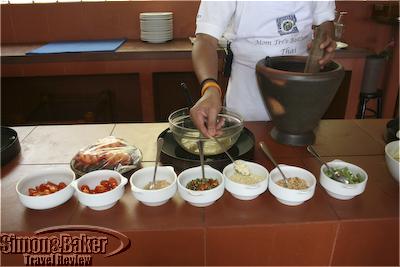
Samples of the food were cooked by the chef
After discussing the menu for the class and the material he would cover the Thai chef shared information about the identification and selection of ingredients when shopping (including options for those of us who were unable to purchase fresh ingredients in our home countries), how best to store each ingredient, ingredient pairings and methods of chopping, dicing and pounding them. He also identified the primary tastes, hot, sour, sweet, salty, bitter and aromatic flavors and discussed how ingredients interact with one another.
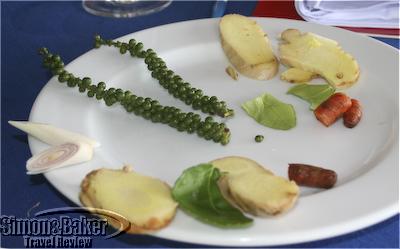
Samples of the common ingredients for the class to examine
He passed around fresh ingredient samples for us to touch and smell. Next the chef showed the class how to prepare a dish before inviting us to prepare it ourselves with his and his staff’s assistance. Then he cooked a small quantity of the items we had prepared so we could taste them before moving on to the following recipe.
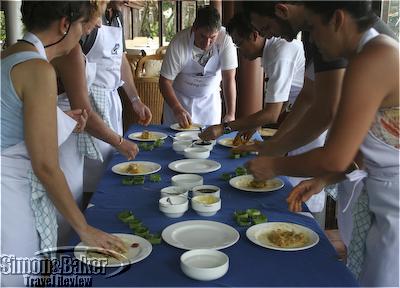
The class prepared each recipe together
When he completed the workshop and answered questions the chef departed, inviting us to relax for an hour until the lunch we had made was cooked in the kitchen and served to us in the dining room. The two-day workshop (Saturday and Sunday) cost 3,500 baht per guest and the one day workshop cost 2,200 baht per guest including lunch at the end of the workshop, an apron, a print out of the recipes and a customized certificate.
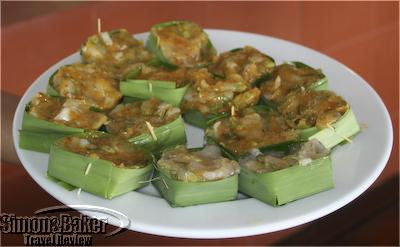
The food prepared by the class went to the kitchen to be cooked
The idea behind the two-day cooking class is for students to learn ten recipes during the two days. During our Saturday session we learned about Thai ingredients, appetizers and salads. The second day, which I missed because I was leaving Phuket that day, featured recipes for main courses and desserts.
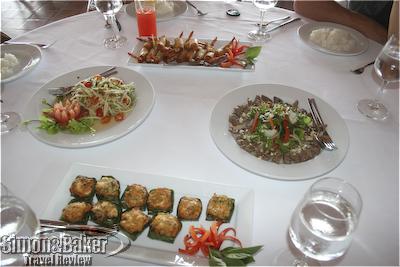
The class consumed the cooked results of their work
You can read more about my meal at The Boathouse at the Simon & Baker Travel Review.




































